|
Both wells drilled through ~3 km of marine and fluvial sediments consisting
of carbonates with occasional interbeded siltstones and mudstones (Tertiary
to Cretaceous) and sandstones interbeded with claystones, siltstones and
coal (Cretaceous to Triassic) before reaching a breccia (Late Permian;
Fig. S-2, 15).
Two of the 14 AGSO regional seismic lines cross over the Bedout High (Fig.
2). In addition, four wells penetrate Permian strata (two are shown
in Fig. 2.) offshore that help to identify
seismic reflectors that define the Bedout structure and stratigraphy.
In both the Lagrange-1 and Bedout-1 cores and cuttings, fluviatile and
marine Keraudren (Middle to Late Triassic) sediments are deposited directly
on top of the breccia (Late Permian; Fig. 4, S-2,
S-3.
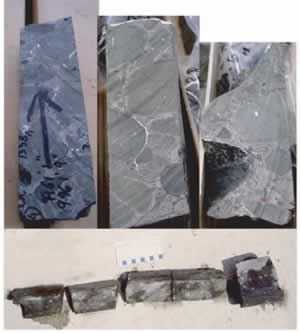 |
Figure 4.
Selected intact 5 cm (wide) core from Bedout-1 at 3035 to 3037 m (9960
to 9965 ft). These cores display variable sized, angular and subrounded
glassy (impact-melted) fragments set in a matrix that is mostly chloritized
and carbonate filled. The smaller glassy fragments examined in thin
section throughout the core (Fig. S-8-S-14) displayed the same mineralogy
and texture as the larger impact-melted glassy fragments seen in hand
specimen. The lower photo is the Yucatan-6 impact melt breccia (from
that has similar characteristics to Bedout-1, particularly in hand
specimen (Yucatan-6 core photo modified from www.icdp-online.de/sites/chicxulub/ICDP-Chix/Figures).
Click
here for larger view) |
| |
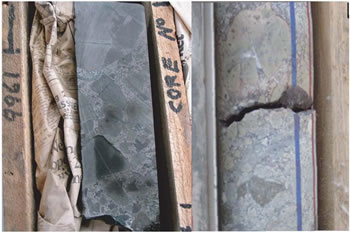 S-3. The Bedout-1 core (A) displays numerous large and sub-rounded
and angular inclusions set in a dense glassy matrix. The term ‘melt
breccia’ is used to describe impact breccias that contain
discrete fragments of rock and minerals together with bodies of melt
in a glassy matrix of fine-grained material. The Bedout melt breccia
is similar in appearance to impact breccias in the Chicxulub Yax-1
core (B) (Yax-1 figure provided by B. Dressler).
S-3. The Bedout-1 core (A) displays numerous large and sub-rounded
and angular inclusions set in a dense glassy matrix. The term ‘melt
breccia’ is used to describe impact breccias that contain
discrete fragments of rock and minerals together with bodies of melt
in a glassy matrix of fine-grained material. The Bedout melt breccia
is similar in appearance to impact breccias in the Chicxulub Yax-1
core (B) (Yax-1 figure provided by B. Dressler).
Click here for larger view) |
Presently the Bedout High stands several kilometers above the surrounding
basement (17). Deep crustal reflections and seismic refraction velocities
also suggest that the Bedout High is under-pinned by elevated middle and
lower crust. Both core and cuttings catalogued as basalts and referred
to as a “volcanic breccia” were recovered from the top of
the High. This regional “volcanism” associated with rifting
of the continental margin of Australia is classified as the “Bedout
Movement” of P/Tr age (18,19). Immediately after the formation of
the Bedout High and termination of the Bedout Movement, there is a regional
angular unconformity at the top of the High, consistent with uplift and
erosion at the end-Permian (20). Coincident with the formation of the
Bedout High is the rifting of the continental "Sibumasu sliver"
off northeastern Gondwana (21). The resulting post-impact tectonism, uplift,
faulting and erosion during the Triassic and Jurassic time periods regionally
overprinted the Bedout structure and deformed the original complex crater
morphology.
The Bedout Breccia
Both the Lagrange-1 and Bedout-1 exploration wells ended in what was inferred
to be a “volcanic breccia”. Fifty-two meters, 30 m of cuttings
and 22 m of core, were collected from the breccia unit in Bedout-1, and
391 m of cuttings were sampled from the breccia unit in the Lagrange-1
drill hole. The Bedout core displays a series of centimeter-sized green
clasts, some with variable banding and others that are poorly sorted (chaotic
dips of 30 to 50 degrees in hand specimen) (Fig. 4,
S-3) over the entire core length (20). Most of the clasts
throughout the core are dark green, massive and appear glassy in hand
specimen but in thin section many are partially altered to fine grained
chlorite or a mixture of fine grained plagioclase, carbonate, and Fe oxides.
We identified unaltered glass and relic igneous mineral grains from the
lower most section of the core (9986 ft) 3044 m (see Figs. 5,
6, 7a, 7b,
7c, 8, S-4,
S-7a, S-7b, S-8,
S-9, S-10, S-11,
S-12, S-13, S-14)
below.
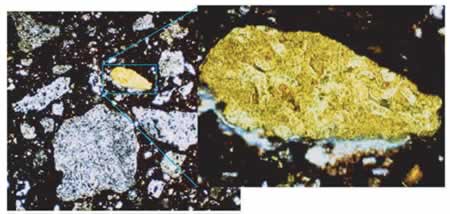 |
| Figure 5 above. (left inset) A typical core sample
from the Bedout impact melt breccia at 3052 m (9986 ft.) displays
a distribution of poorly sorted angular and sub-angular clasts in
a dark glassy matrix (scale of picture is 6.5 mm - long dimension).
Under higher magnification (right inset), the yellowish clast appears
to be a partially melted carbonate clast with fossil ooids characteristic
of a marine continental (carbonate reef ) margin environment.
Click here for larger view) |
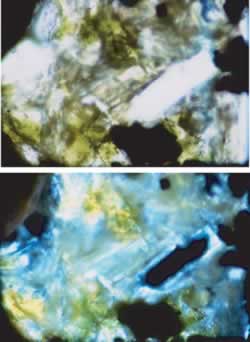 |
| S-4. Top photomicrograph of Bedout 3044
m (9986 ft.) in plane light shows transparent plagioclase lath
set in matrix of plagioclase microlites, opaques and altered
glass. Lower photomicrograph shows same view in crossed nicols
with maskelynite core (as isotropic glass) of plagioclase lath.
Field of view is 330 µm.
Click here for larger view) |
|
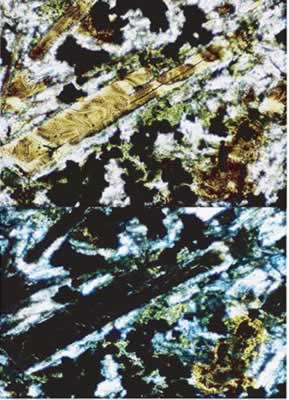 |
Figure 6. Photomicrograph in plane polarized
light of Bedout-1 at 3044 m (9986 ft.) showing a large plagioclase
lath (yellow brown color indicative of alteration) that has
been shock melted. Another lath at upper left has also been
shock melted (slide width 550Ám). The shock melted plagioclase
glass is in the process of alteration (green). The matrix is
composed of opaque Fe-Ti oxides (black) and crystalline albite
(clear). The lower picture is the same view under crossed nicols.
All of the plagioclase laths are now extinct (black-opaque)
at all orientations indicating conversion to maskelynite, shock
melted glass that suggests an impact. Note that the two maskelynite
laths are at slightly different orientations yet both are completely
extinct.
Click
here for larger view) |
|
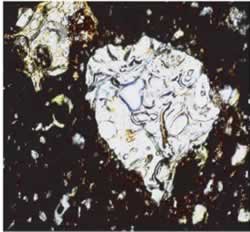 |
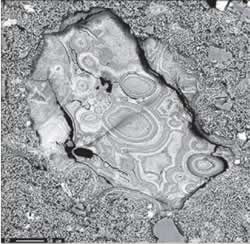 |
| Figure 7 (A). Photomicrograph of shock melted fragments
of spherulitic glass from Bedout 3044 m (9986 ft) set in a matrix
of dark glass. Similar spherulitic glass has been identified in other
terrestrial craters (Chicxulub, Sudbury). Width of slide is 1.0 mm.
Click here for larger view) |
Figure 7 (B). Back Scattered Electron
Image of another spherulitic glass fragment from Bedout at 3044 m
(9986 ft). The large grain of nearly pure silica (Table S-1, analyses
#22 and #24). Similar textures have been observed in BSE images of
the Chicxulub suevite. Scale bar is 50 Ám.
Click here for larger view) |
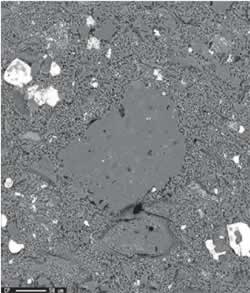 |
Figure 7 (C) (left). Back Scattered
Electron Image of high silica glass from Bedout 3044 m (9986 ft.)
The large grain of nearly pure silica (analyses #22 and #24) in the
center of the image is set in a matrix of plagioclase, altered glass
and Fe-Ti oxides. Note the dark and light areas of the BSE image that
correspond to different levels of impurities in the silica glass.
Oridinary volcanic processes cannot produce glass of >85% silica.
Scale bar is 50 Ám.
Click here for larger view) |
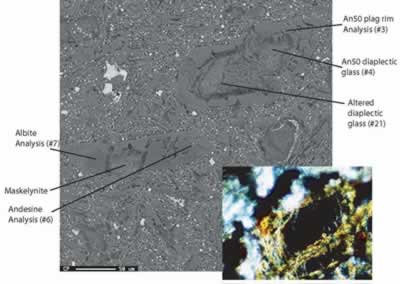 |
Figure
8. Shock melted plagioclase grains set in a matrix of albite, Fe-Ti
Oxides and glass that is altering to chlorite 3044 m (9986 ft.). The
rim of the large grain in the upper right is crystalline plagioclase
(visible in X- nicols in figure inset) with a composition of An50
(analysis 3 in Table S-1). The core of this grain is isotropic glass
with an identical composition of An50 plagioclase (analysis 4). Single
plagioclase lath (left of center) contains andesine plag (An50) (right
side of grain, point 6), diaplectic glass in the center and pure albite
(point 7) on the left.
(Click here for larger view) |
| |
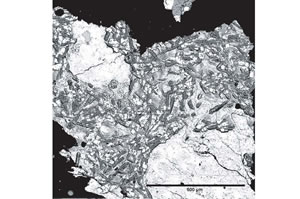 |
 |
| S-7a,b.
Lagrange-1 (LG-3255 m) cuttings sample (S-7a left photo) displays
feldspar crystallites in 'swallowtail' terminations, indicative of
rapid crystallization from the glassy matrix. The laths display heteorgeneous
compositions (Table S-2) derived from the impact process and are chemically
unique in comparison to ordinary volcanic feldspars. S-7b. (right
photo) S-1 denotes the chemistry of albite, #2, feldspar and #3, the
glass matrix (see Table S-2). (Click here for larger view) |
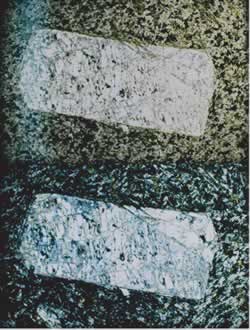 |
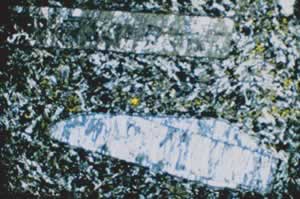
S-9. (above) Altered plagioclase laths under crossed nicols from the
Bedout-1 core at 3041 m (9977 ft.; B-9977). Note the shattered lamellae
perpendicular to the length of the plagioclase crystals. Fractured/altered
plagioclases in B-9977 have suffered argon loss and perhaps K addition
resulting in anomalously young Ar/Ar ages. Long dimension of slide
is 3 mm. (Click
here for larger view) |
S-8 (above). A single plagioclase lath
with multiple sets of fractures from 3041 m ( B-9977 ft.). Lamellae
structures are approximately perpendicular to the length of the crystal.
Upper photo is in plane polarized light; lower photo is under crossed
nicols. Long dimension of slide is 3 mm.
(Click here for larger view) |
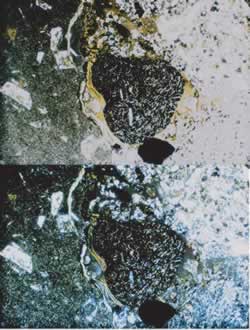
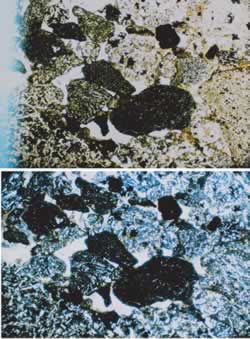 |
S-12 (above) Heterolithic glassy, microcrystalline
fragments from 3036 m (9960 ft). Notice the different shapes
and sizes of clasts with varying degrees of microcrystallinity
of the plagioclase microlites. Brighter, white areas are carbonate.
Upper photo is in plane polarized light; lower photo is taken
under crossed nicols. Long dimension is 3mm.
(Click here for larger view)
|
|
S-10 (right) A glassy fragment from Bedout-1 at 3036 m (B-9960').
Upper photo is in plane light; lower photo is under crossed nicols.
Several clasts contain mostly dark colored glass with microlites of
plagioclase feldspar, rimmed by brownish glass with a flow pattern.
This glass is partially chloritized. Notice the black fragment (likely
coal) lower center. To the far upper/lower right are microcyrstalline
feldspar (whitish) of distinctly different composition that contrast
to the darker glassy fragments. Long dimension of slide is 3 mm.
(Click
here for larger view)
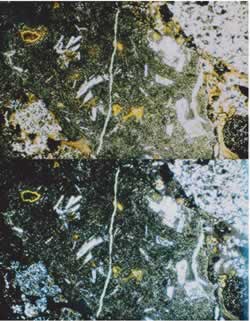 |
S-11 (above) Multiple, glassy, microcrystalline clasts in 3036 m (9960 ft. B-9960).
Variable glass compositions are indicated by different colors
in plane polarized light (upper photo). Notice the brownish,
glassy patches, partially chloritized within the larger, darker,
glassy fragments. Alternatively, these glassy pathes could
be be later pore/vug fillings/alteration phases now chloritized.
The thin vein in the center is calcite. Long dimension is
3 mm.
(Click
here for larger view) |
|
 |
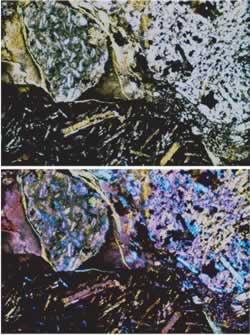 |
S-13. Calcite and glassy vein between
two dark, glassy feldspar microcrystalline fragments in 3037 m (9964
ft). Colors are enhanced in the lower photo under crossed nicols by
insertion of a gypsum plate. Long dimension is 0.6 mm.
(Click here for larger view) |
S-14. Heterolithic glassy, microcrystalline fragments
with interstitial altered glass in 3037 m (9964 ft). Upper photo is
in plane polarized light. Lower photo (crossed nicols) has interference
colors enhanced by insertion of a gypsum plate. Long dimension of
slide is 0.6 mm. (Click
here for larger view)
|
|







